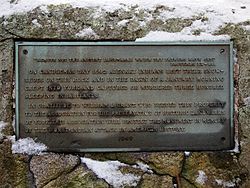Raid on York (1692) facts for kids
Quick facts for kids Raid on York (1692) |
|||||||
|---|---|---|---|---|---|---|---|
| Part of King William's War | |||||||
 Memorial plaque in York, ME |
|||||||
|
|||||||
| Belligerents | |||||||
Acadia Abenaki |
|||||||
| Commanders and leaders | |||||||
| Chief Madockawando, Father Louis-Pierre Thury Sr. de Portneuf |
Preble, John Harmon, Alcock, and Norton | ||||||
| Strength | |||||||
| 200-300 Abenaki and Canadiens | |||||||
| Casualties and losses | |||||||
| unknown | 75 killed and 100 prisoners Abenaquis reported killing or capturing 187 people | ||||||
The Raid on York, also known as the Candlemas Massacre, happened on January 24, 1692. During this event, a group of 200-300 Abenaki people and Canadiens (French settlers from Canada) attacked the town of York. At the time, York was part of the Province of Massachusetts Bay. The attack was led by Chief Madockawando and Father Louis-Pierre Thury.
During the raid, about 100 English settlers were killed. Around 80 villagers were also taken hostage. These captives were forced to walk to New France, which was a French colony in North America. Later, Captain John Alden Jr. from Boston helped to get them back.
Contents
What Happened at York?
The Raid on York was part of a larger conflict called King William's War. This war was fought between the French and their Native American allies against the English colonies in North America. The attack on York was a surprise. The attackers moved quietly into the town.
The Attack
The group of Abenaki and Canadiens attacked the English settlers. They burned many buildings in the town. Captain Floyd, an English officer, later wrote that "the houses are all burned and rifled except the half dozen or thereabout." He also noted that "about seventeen or eighteen houses burned."
Many people were killed during the raid. Captain Floyd reported burying 48 people. Other reports suggest that nearly 50 people were killed and about 100 were captured.
Notable Victims and Captives
Among those killed was Reverend Shubael Dummer, who was the minister of the local church. His wife, Lydia, and their son were taken captive. Lydia sadly died later due to the difficult journey and harsh conditions. Nothing more was heard about their son.
The attackers set fire to all houses that were not defended. These houses were mainly on the north side of the York River. This river was important for trade and the town had grown around it.
One of the young people taken captive was Jeremiah Moulton. He was later released and became a well-known figure. He played an important role in future conflicts, like Dummer's War.
Aftermath and Legacy
After the attack, the town of York was mostly destroyed. However, the settlers did not give up. They rebuilt the town on higher ground. This new location is where York Village stands today.
Memorial in York
In York, there is a special memorial plaque on a large stone. According to the plaque, this is where the Abenaki warriors left their snowshoes. They did this before quietly moving into York to attack the settlers. This plaque helps people remember the events of that day.

